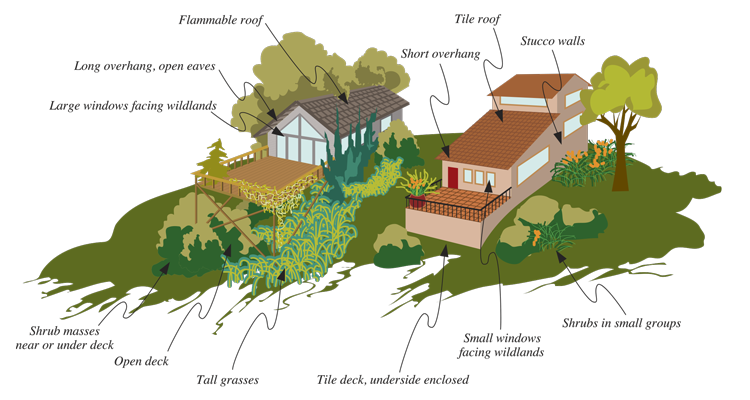Fire affects everyone living in California
The guidelines below are intended to reduce fire hazard, but cannot guarantee fire safety. The best strategy for minimizing damage from wild fires is to manage, on a long-term basis, the structural conditions that fuel a fire. Factors to consider include:
- Character of the natural and built environment
- Building location, design, and materials
- Landscape design
- Irrigation system
- Ongoing maintenance
Order the firescape booklet
EBMUD's free firescape booklet provides guidelines for landscapes in fire-prone areas. Available as a hardcopy or a downloadable PDF.
Where you live affects your vulnerability to fire
Begin by assessing the hazards in your surroundings. Is your home on a grassy hillside or in a wooded canyon? Fire tends to travel fastest uphill by preheating dried vegetation from below and making it easier to ignite. The steeper the slope, the faster a fire will spread.
Arrangement and spacing of vegetation are critical
Wildfires through out California in recent years attest to the destructive potential of flammable vegetation adjacent to homes and other structures. Two primary principles guide firewise landscape design: fuel reduction and interruption of the “fire path”– the horizontal or vertical continuity of fuel.

Resources
Order the full firescape booklet
EBMUD's free firescape booklet provides guidelines for landscapes in fire-prone areas. Available as a hardcopy or a downloadable PDF.
EBMUD Emergency Preparedness
Additional information for you and your family, including wildfire evacuation tips.
California Native Plant Society Fire Recovery Guide
Downloadable guide about landscaping after a wildfire.
Orinda Plant Guide
A quick reference guide on what and where to plant.
Sonoma-Marin Design Templates
Free landscape design plans and recommendations that are relevant for all Bay Area landscapes.